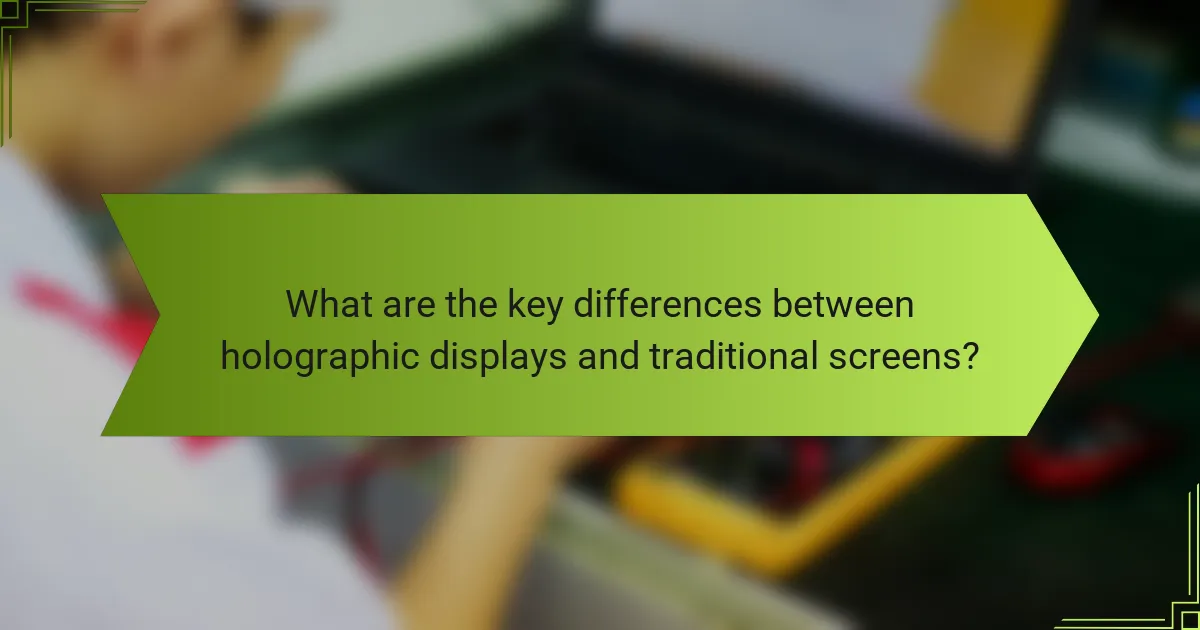The comparison between holographic displays and traditional screens reveals significant differences in user experience. Holographic displays offer immersive, three-dimensional visuals that engage users in interactive ways, while traditional screens provide a more familiar, two-dimensional interface. As emerging technology, holographic displays promise innovative experiences, though they may face challenges in cost and accessibility compared to their established counterparts.

How do holographic displays enhance user experience in urban environments?
Holographic displays significantly enhance user experience in urban environments by providing interactive, visually striking, and contextually relevant information. These displays create a more engaging atmosphere, allowing users to interact with digital content in ways that traditional screens cannot offer.
Immersive interaction
Holographic displays facilitate immersive interaction by allowing users to engage with 3D content using gestures and movements. This hands-on approach fosters a deeper connection with the information presented, making navigation and learning more intuitive. For instance, users can manipulate virtual objects to explore urban layouts or historical sites, enhancing their understanding and enjoyment.
In urban settings, this type of interaction can be particularly beneficial in public spaces like museums or transportation hubs, where users can access information without needing to touch a screen. This reduces the spread of germs and creates a more hygienic experience.
Enhanced visual appeal
The visual appeal of holographic displays is a key factor in enhancing user experience. These displays can project vibrant, lifelike images that capture attention and convey information more effectively than traditional screens. The ability to present content in three dimensions allows for a more engaging visual narrative, making it easier for users to absorb complex information.
For example, in urban advertising, holographic displays can showcase products in a way that feels more dynamic and exciting, potentially increasing consumer interest and engagement. This visual impact can transform mundane urban landscapes into interactive experiences.
Real-time data visualization
Holographic displays excel in real-time data visualization, providing users with up-to-date information in an easily digestible format. In urban environments, this capability is crucial for applications such as traffic monitoring, public transport updates, and emergency alerts. Users can quickly grasp essential information without sifting through text-heavy displays.
For instance, a holographic display at a subway station can show real-time train schedules and delays, allowing commuters to make informed decisions on the spot. This immediacy enhances user satisfaction and improves overall efficiency in navigating urban spaces.

What are the key differences between holographic displays and traditional screens?
Holographic displays and traditional screens differ primarily in how they present images and the user experience they provide. Holographic displays create three-dimensional visuals that can be viewed from multiple angles, while traditional screens typically offer flat, two-dimensional images.
Depth perception
Depth perception in holographic displays allows users to see images as if they exist in three-dimensional space. This is achieved through light field technology, which projects images that appear to have volume and depth, enhancing realism. In contrast, traditional screens lack this capability, presenting flat images that can lead to a less immersive experience.
For applications like medical imaging or architectural visualization, depth perception can significantly improve understanding and interaction with complex data. Users can gauge spatial relationships more effectively with holographic displays, making them ideal for detailed analysis.
Viewing angles
Holographic displays offer superior viewing angles compared to traditional screens, allowing multiple users to view the same image without distortion. This is particularly beneficial in collaborative environments where several people need to see the same content simultaneously. Traditional screens, however, often suffer from color and brightness degradation when viewed from angles outside their optimal range.
In practical terms, a holographic display can maintain clarity and detail from various perspectives, making it suitable for presentations and group discussions. Users should consider their typical viewing scenarios when choosing between these technologies.
Space requirements
Holographic displays generally require more space than traditional screens due to their need for specialized equipment and setup. They often involve additional components like projectors or sensors to create the 3D effect, which can necessitate a dedicated area. Traditional screens, on the other hand, can be easily mounted on walls or placed on desks, making them more versatile for standard office or home environments.
When planning for installation, consider the physical space available and the intended use. If a large, immersive experience is desired, investing in a holographic setup may be worthwhile, but ensure that the space can accommodate it comfortably.

How do traditional screens perform in comparison to holographic displays?
Traditional screens typically offer a more established user experience compared to holographic displays, which are still emerging technologies. While traditional screens are widely used and understood, holographic displays promise unique visual experiences but may come with limitations in cost and accessibility.
Cost-effectiveness
Traditional screens are generally more cost-effective than holographic displays. Prices for standard LCD and LED screens can range from low tens to several hundred USD, depending on size and features. In contrast, holographic displays often require advanced technology and materials, leading to significantly higher price points, often in the thousands of USD.
For consumers and businesses on a budget, traditional screens provide a reliable option without the premium costs associated with holographic technology. However, as holographic technology advances, prices may decrease, making them more accessible in the future.
Energy consumption
Energy consumption is another area where traditional screens tend to outperform holographic displays. Most conventional screens, such as LED and OLED, are designed to be energy-efficient, consuming around 30 to 100 watts depending on size and usage. Holographic displays, while innovative, often require more power to operate due to their complex projection systems.
When considering energy costs, traditional screens may lead to lower utility bills over time, making them a practical choice for long-term use. Users should evaluate their energy needs and consider the potential for higher consumption with holographic options.
Image clarity
Image clarity is a strong point for both traditional screens and holographic displays, but they achieve it differently. Traditional screens offer high resolutions, with many models supporting 4K and even 8K displays, providing sharp and detailed images. Holographic displays, on the other hand, aim to create three-dimensional visuals that can enhance depth perception but may struggle with resolution and detail compared to high-end traditional screens.
Users seeking crisp, clear images for tasks like graphic design or gaming may prefer traditional screens, while those interested in immersive experiences might find holographic displays appealing despite potential clarity trade-offs. It’s essential to assess the specific use case when choosing between the two technologies.

What are the user preferences for holographic displays in retail settings?
User preferences for holographic displays in retail settings often lean towards enhanced interactivity and immersive experiences. Shoppers appreciate the ability to engage with products in a more dynamic way, which can influence their purchasing decisions.
Customer engagement
Holographic displays significantly boost customer engagement by providing interactive experiences that traditional screens cannot match. Shoppers are drawn to the novelty and excitement of 3D visuals, which can lead to longer dwell times in stores. Retailers can leverage this by incorporating interactive elements, such as touch-responsive features or augmented reality overlays.
For example, a clothing store might use holograms to allow customers to visualize outfits on virtual models, enhancing the shopping experience and encouraging exploration of products.
Product visualization
Holographic displays excel in product visualization, offering a three-dimensional view that helps customers better understand the size, shape, and features of items. This capability is particularly beneficial for complex products, such as electronics or furniture, where details matter. Customers can rotate and examine products from various angles, which traditional screens cannot provide.
Retailers should consider using holograms for showcasing new or high-end products, as this can create a memorable impression and facilitate informed purchasing decisions.
Sales conversion rates
Implementing holographic displays can positively impact sales conversion rates by creating a unique shopping experience that differentiates a retailer from competitors. Studies suggest that engaging displays can increase conversion rates by a notable margin, often in the range of 20-30%. This increase is attributed to the enhanced customer experience and the ability to visualize products more effectively.
Retailers should monitor sales data closely after introducing holographic displays to assess their impact and adjust strategies accordingly, ensuring that the investment translates into higher sales.

What criteria should businesses consider when choosing between display technologies?
When selecting between holographic displays and traditional screens, businesses should evaluate factors such as target audience, budget constraints, and space limitations. These criteria will help determine which technology aligns best with their operational needs and goals.
Target audience
Understanding the target audience is crucial when choosing display technologies. For instance, if the audience consists of tech-savvy individuals, holographic displays may enhance engagement and interest. Conversely, traditional screens might suffice for more general audiences who prioritize functionality over novelty.
Additionally, consider the context in which the display will be used. Retail environments may benefit from eye-catching holographic displays to attract customers, while corporate settings might prefer the reliability of traditional screens for presentations and meetings.
Budget constraints
Budget is a significant factor in deciding between holographic displays and traditional screens. Holographic technology typically involves higher initial costs, including equipment and installation. Businesses should assess whether the potential return on investment justifies these expenses.
On the other hand, traditional screens are generally more affordable and widely available, making them a practical choice for companies with tighter budgets. It’s essential to weigh the long-term benefits against the upfront costs to make an informed decision.
Space limitations
Space considerations play a vital role in display technology selection. Holographic displays often require more room for optimal viewing angles and audience engagement. Businesses with limited space may find traditional screens easier to integrate into their existing environments.
Moreover, consider the layout and design of the space. If the display needs to be viewed from multiple angles or distances, ensure that the chosen technology can accommodate these requirements without compromising visibility or user experience.

How do holographic displays impact user training and education?
Holographic displays significantly enhance user training and education by providing immersive and interactive experiences. These displays allow users to visualize complex concepts in three dimensions, improving comprehension and retention.
Interactive learning
Holographic displays facilitate interactive learning by enabling users to engage with 3D models and simulations. This hands-on approach allows learners to manipulate objects, view them from various angles, and explore intricate details that traditional screens cannot provide.
For example, in medical training, students can interact with lifelike holograms of human anatomy, allowing them to practice procedures in a safe environment. This type of immersive experience can lead to better understanding and skill acquisition compared to passive learning methods.
To maximize the benefits of interactive learning with holographic displays, educators should incorporate guided exercises that encourage exploration and experimentation. Avoid overwhelming learners with too much information at once; instead, focus on incremental learning that builds on previous knowledge.
